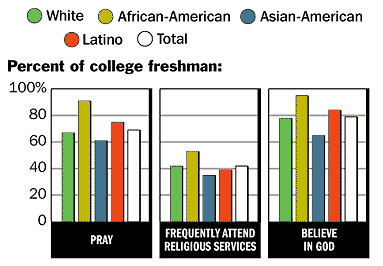
Story at the Christian Science Monitor, via Asian Nation.
—————————
Lisa Wade is a professor of sociology at Occidental College. You can follow her on Twitter and Facebook.

Story at the Christian Science Monitor, via Asian Nation.
—————————
Lisa Wade is a professor of sociology at Occidental College. You can follow her on Twitter and Facebook.
In the U.S. today, men enroll in college at a lower rate and drop out at a higher rate. In 2005, there were 57 women on campus for every 43 men.
This is such a significant problem, that college admissions officers are letting in a larger percentage of male applicants, even sometimes admitting less qualified men over more qualified women.
But this isn’t just a gender story.
A USA Today story offered this data from the ACE Center for Policy and Analysis:
Looking at the very bottom line of the table (and just at 2003/2004), you can see that the gender gap is largest among lower income students. Men make up 40% of undergraduates 18-24 when you consider low-income students only, and 49% when you look at upper income students.
The gender gap also correlates with race. Asian students show the smallest gender gap, whites the next smallest, with Hispanics and blacks trailing.
You might notice that the correlation of the gender gap with race mirrors the class correlation. That is, income and wealth data for racial categories follows the same pattern with Asians out earning whites (categorically speaking) and whites out earning Hispanics and blacks. So there may be an interesting exacerbation effect here.
The gender gaps for each racial/ethnic group, however, decreases as the students’ families get richer. And, among the upper income groups, the racial difference shrinks to only three percentage points (from 11 among low- and middle-income kids).
So, it’s not just about race, it’s not just about class, and it’s not just about gender. Then, what is it about being poor, black or Hispanic, andmale that results in low male enrollment in college and a higher drop out rate?
—————————
Lisa Wade is a professor of sociology at Occidental College. You can follow her on Twitter and Facebook.
Angry Asian Man wrote about two East High Schools–in Rochester, New York and Akron, Ohio–with a peculiar mascot: the Orientals.
East High School merch (Rochester, New York):
Screen shot of the East High School website (Akron, Ohio):
Notice the Asian-y font and the stylistic dragon.
When high schools and sports teams recruit a type of person as a mascot, it objectifies and caricatures them. It also encourages opposing teams to say things like “Kill the Orientals.” This can only be okay when we aren’t really thinking about these kinds of people as real humans beings.
This reminded me: As an undergraduate, I went to the University of California, Santa Barbara. Our mascot was the Gaucho, which I remember being described as a Mexican cowboy (though South American cowboy may be more descriptive). I went by the UCSB website and found these two logos. There is a story about the first identifying it as a brand new logo; the second is for kids:
I am troubled by the Gaucho mascot for the same reasons that I don’t like the Orientals mascot, but at least authentic gauchos are not likely to enroll at UCSB the way that “Orientals” are likely students of the East High Schools.
Then again, this is the image on the front page of the UCSB athlectics website:
It does indeed read: “GLORY. HONOR. COURAGE. TORTILLAS.” This seems to invalidate any argument that the use of the Gaucho mascot is “respectful.”
Thinking about the Orientals and the Gauchos, alongside the many American Indian mascots still found in the U.S., Notre Dame’s Fighting Irish, and the soccer team in the Netherlands who call themselves the Jews, may give us some perspective on this mascot phenomenon that thinking about one at a time doesn’t. If we feel that one of these mascots is less discriminatory than another, what drives that feeling? And is it logical? Or does it stem from a trained sensibility that isn’t applied to all marginalized groups across the board? Or is it in response to different characteristics of these different groups? Or different contexts?
Maybe all five mascots are equally offensive and offensive for the same reasons. But thinking about them together may also be useful for teasing out how, exactly, they are offensive. What do you think?
—————————
Lisa Wade is a professor of sociology at Occidental College. You can follow her on Twitter and Facebook.
On the heels of our Frito Bandito post, comes this (I think) 1975 ad for Tequila Gavilan. Slogan: “One taste…and you’re not a Gringo anymore.”
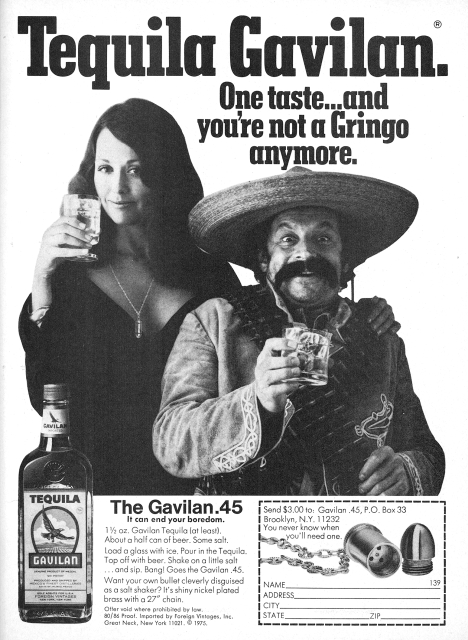
If I’m reading this ad correctly, both the woman and the man in this ad are supposed to be Mexican. What’s interesting, then, is the different social construction of Mexican men and women. While the male is the familiar “Frito Bandito,” sombrero-wearing fool, the female is a hot, spicy Latina. Today the Mexican fool is a risky stereotype to pull out, but the hot spicy Latina is still a very common trope.
From another angle, this reminds me a bit of the history of colonization and war. All too frequently, male ethnic others in war are considered enemies, while female ethnic others are considered the spoils of war. So the idea that the racially-othered men are disposable, while “their” women are desirable has a very long history in Western thought (see, for example, Joane Nagel’s great book, Race, Ethnicity, and Sexuality).
—————————
Lisa Wade is a professor of sociology at Occidental College. You can follow her on Twitter and Facebook.
Mary M., of Cooking with the Junior League (go read it now! It’s awesome!) sent in photos she took of several pages from House Dressing, a cookbook published by the Windsor Square-Hancock Park Historical Society in 1978 (Hancock Park is a wealthy section of L.A.). The cookbook contains a section called “Kitchen Spanish,” which, as Mary says, “pretty much amounts to phrases you can use to boss around your help.” They are quite thorough, providing terms not just for cooking but for many other household tasks, and specific terms for wool vs. silk clothing. Here are images of a couple of the pages:
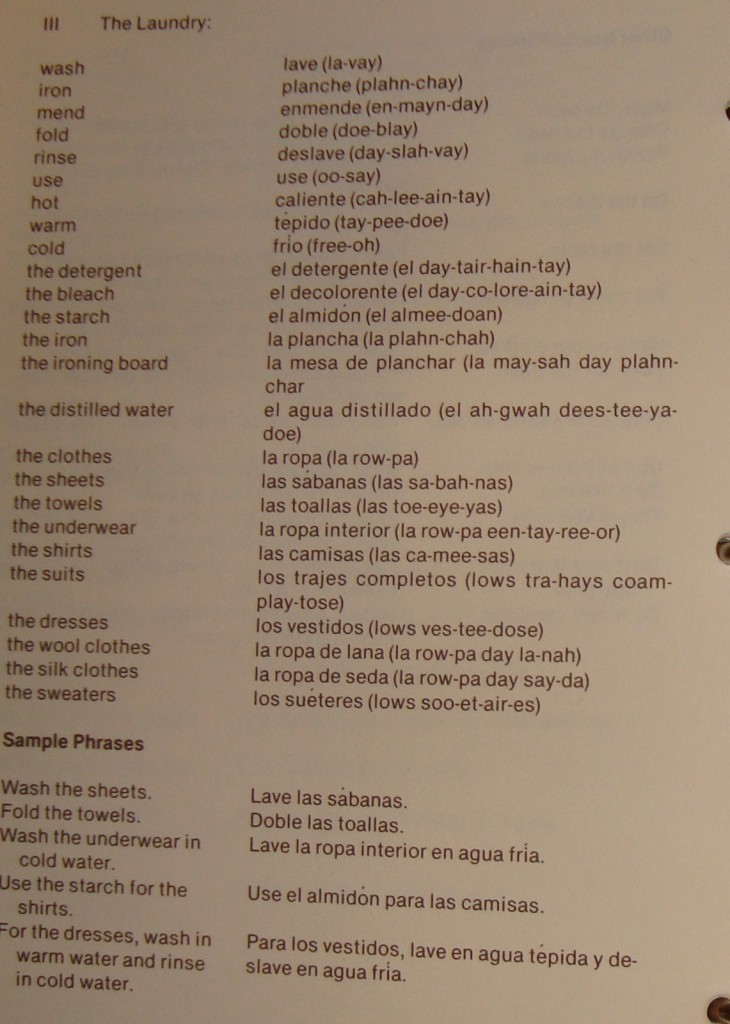
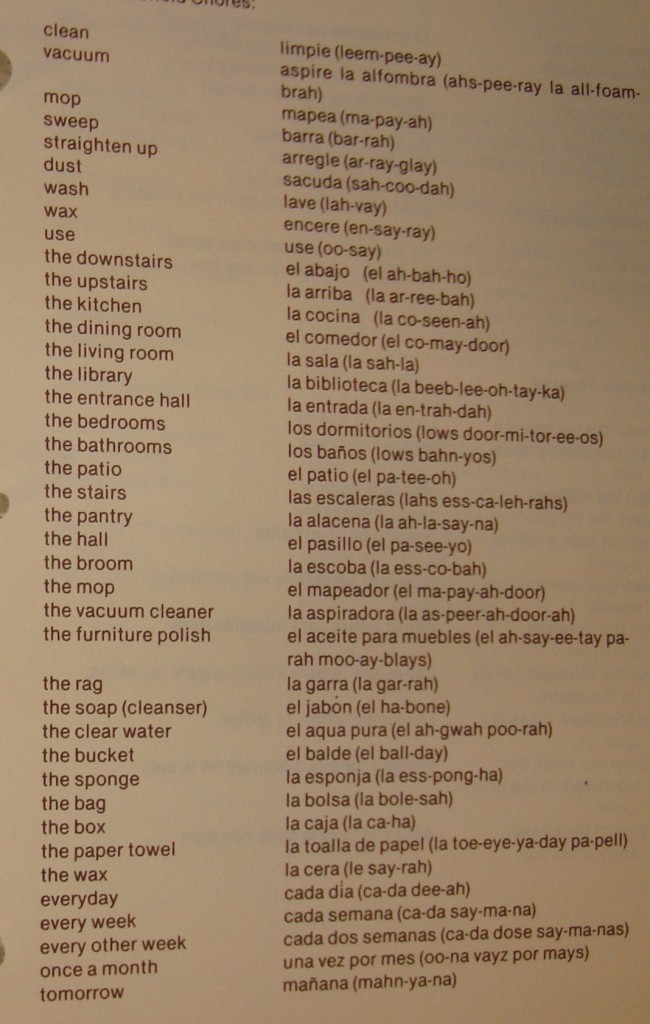
And here we have my favorites, “This is still dirty” and “Do it very thoroughly this time”:
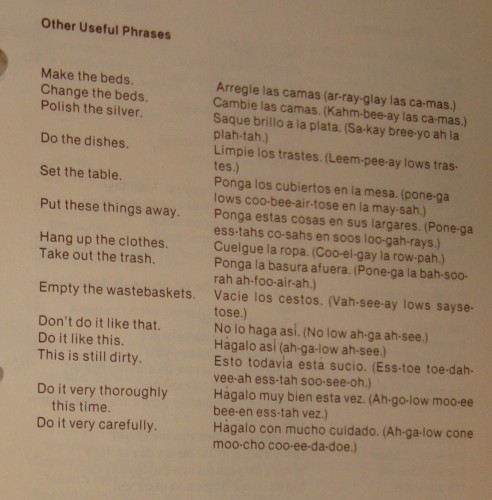
And to think, when I first read the phrase “Kitchen Spanish” I assumed it was a geographically confused title for the Tex-Mex recipe section. Also, given that the pronunciation guides don’t include instructions on which syllable to emphasize, I can only imagine what kind of directions the employees actually received.
It made me think of the book Domestica: Immigrant Workers Cleaning and Caring in the Shadows of Affluence, by Pierrette Hondagneu-Sotelo. She discusses the tensions and conflicts that often arise between immigrant (largely Latina) housekeepers/nannies and their (mostly White and female) wealthy employers over how tasks should be done. Domestic workers generally expressed a wish to be told what to do, but not how to do it (and not watched while they worked), while employers felt they had to provide a lot of micromanagement if they wanted tasks done to their standards. Many instances where employees quit or employers fired them resulted from the conflict over this issue.
My guess would also be that many of the individuals contributing to and buying this cookbook would not be cooking anything from it themselves. The cookbook probably served as a form of symbolic domesticity for wealthy women to share recipes, while the women doing much of the actual cooking and cleaning in their households were present only implicitly as the recipients of the instructions on these pages. As Mary pointed out, something similar was probably true of all the “signature recipes” of First Ladies are often shown serving in photo ops–it seems likely that many of them had nothing to do with the preparation and may not have even supplied the recipe. Didn’t John McCain’s wife (I know, not a First Lady, but she was a hopeful) post a recipe on the campaign website that turned out to be taken from another cooking website?
NEW! (July ’10): Jason K. sent in another example, this one published in 1976:
 The Women’s Media Center has compiled a series of clips exposing the racist and sexist discourse surrounding Sotomayor’s nomination to the Supreme Court:
The Women’s Media Center has compiled a series of clips exposing the racist and sexist discourse surrounding Sotomayor’s nomination to the Supreme Court:
Via Racialicious.
—————————
Lisa Wade is a professor of sociology at Occidental College. You can follow her on Twitter and Facebook.
Republicans’ outrage, both real and feigned, at Sotomayor’s musings about how her identity as a “wise Latina” might affect her judicial decisions is based on a flawed assumption: that whiteness and maleness are not themselves facets of a distinct identity. Being white and male is seen instead as a neutral condition, the natural order of things. Any “identity” — black, brown, female, gay, whatever — has to be judged against this supposedly “objective” standard.
Thus it is irrelevant if Justice Samuel A. Alito Jr. talks about the impact of his background as the son of Italian immigrants on his rulings — as he did at his confirmation hearings — but unforgivable for Sotomayor to mention that her Puerto Rican family history might be relevant to her work. Thus it is possible for Sen. Jeff Sessions (R-Ala.) to say with a straight face that heritage and experience can have no bearing on a judge’s work, as he posited in his opening remarks yesterday, apparently believing that the white male justices he has voted to confirm were somehow devoid of heritage and bereft of experience.
Stephen Colbert:
| The Colbert Report | Mon – Thurs 11:30pm / 10:30c |
| The Word – Neutral Man’s Burden | |
If you can’t view the video, there’s a transcript after the jump, thanks to Macon D at Stuff White People Do.
In the Sotomayor confirmation hearings, Republicans have swarmed on Ricci v. DeStefano, the New Haven firefighters case. To hear them tell it, Sotomayor flung the law aside in upholding the lower court decision. She, the majority of the Second Circuit Court, the Federal judge who wrote the original opinion, and the four dissenting Supreme Court justices all based their opinions entirely on a preference for blacks and Hispanics and an animus towards whites. They didn’t consider the law.
By contrast, the five males (four of them white) on the Supreme Court who sided with the white male plaintiffs based their decision wholly and impartially on the law. Their race had nothing to do with it.
The Republican strategy depends on the tendency for privilege to remain invisible.
The transcript after the jump:
Oh, man. As if we needed another reminder as to why cartoon art is a medium that can be used for evil as easily as good, comes now the next installment in a series of racist National Review covers trafficking in Asian stereotypical imagery.
You’ll remember, of course, that back in March 1997, the National Review released the infamous “Manchurian Candidates” cover seen here (which, due to the fact that the Internet was just a tot when that slice of tripe hit the newsstands, I was only able to find in embedded in a journal article written by Darrell Hamamoto, w00t!).
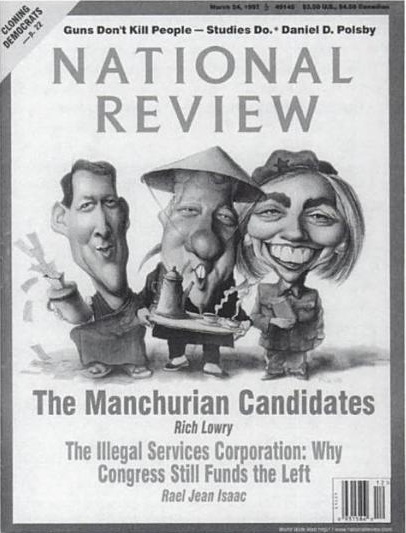
Asian Americans understandably reacted with stunned rage at the depiction of then-President Bill Clinton, First Lady Hillary Clinton, and Vice-President Al Gore in stereotypical Chinese garb, their features warped into exaggerated Asian caricatures (slanted eyes, buck teeth).
The National Review was unrepentant in the face of charges that the cartoon was offensive and inflammatory, responding, in part, that:
Caricatures and cartoons …require exaggerated features and, where a social type is portrayed, a recognizable stereotype. Thus, a cartoonist who wants to depict an Englishman will show him wearing a monocle and bowler hat, a Frenchman in beret and striped jersey, a Russian in fur hat, dancing the gopak, etc.
The first point can’t entirely be disputed: The cartoon medium often uses simplified, exaggerated features for emphasis, for satirical purpose and for ease in depicting broad emotion.
But it’s one thing to exaggerate features — Obama’s protruding ears invariably become giant jug-handles when he’s rendered, for instance. The Mike Ramirez cartoon below actually essentializes Obama’s appearance down to his ears — and still manages to make its point clear.
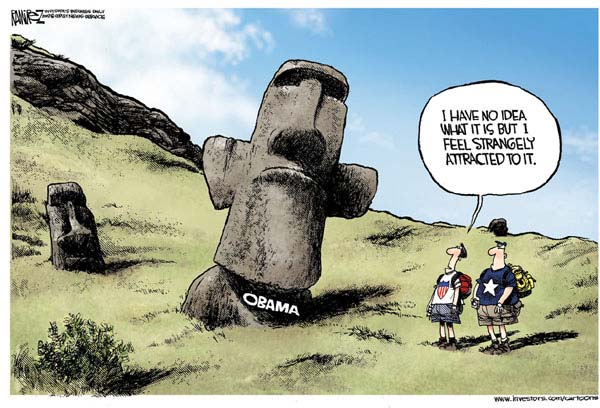
It’s another to incorporate racialized features that weren’t there to begin with: For instance, consider these images — a caricature of Obama from an “Obama Waffles” package, as gleefully sold during the right-wing ” Values Voters Summit,” and a close-up of Obama’s official portrait from his days as Senator from Illinois.
Apart from being overtly racist, the caricature on the box doesn’t remotely resemble Obama — with its pop-eyed expression, darkened skin, enormous, toothy grin and thick lips, it looks a lot more like…well, the picture below can speak for itself, I guess.
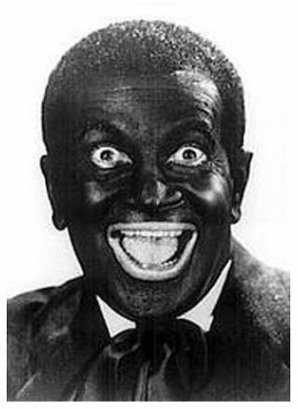
Going back to the National Review “Manchurian Candidates” cover now, what you see is that there’s more going on in the images of the Clintons and Gore than the typical flamboyant exaggeration used in cartooning. In addition to Bill’s bulbous nose and Gore’s pursed, almost sneering lips (both typical of their respective caricatures), you see…hmm…narrowed eyes… oversized, bucked teeth… a Fu Manchu moustache– hey, just about every racist synecdoche in the anti-Asian propaganda library! (At least the stuff that belongs above the waist.)
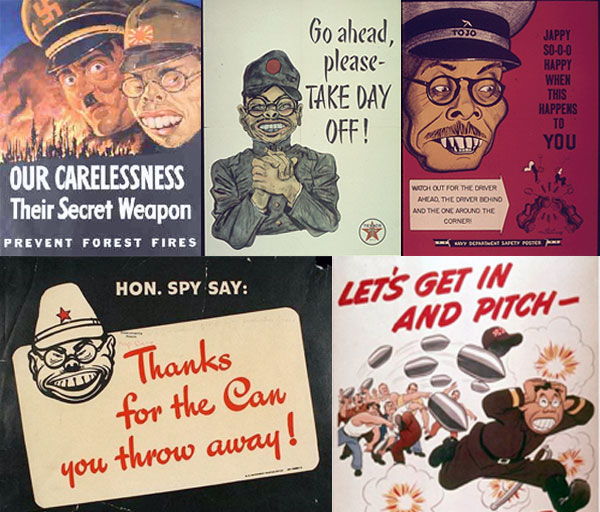
Just to be clear here: It’s one thing if they were simply drawn in Chinese clothing or doing quaint folkdances, as suggested by the National Review in its disgenuous response. That would arguably be in-bounds satirically (regardless of whether you find the political point being made to be fair or accurate).
But layering yellowface-propaganda memes into the picture transforms the caricature from an act of humor into an act of war. The images to the right are examples of what I’m talking about.
Even if you’re insensitive enough to racial propriety to want to give white people Asian features in order to prove a political point, that simply isn’t what Asian people look like, and never has been. The squinty, buck-toothed Asian person with bright yellow skin and eyes angled at ten minutes to two does not exist in nature. However much you soften it, those false features are in fact weapons of mass destruction, artifacts of an era where it was used to dehumanize the enemy enough so they could be killed without compunction.

For that reason, there’s no acceptable way they should be invoked in a casual popular context, any more than minstrel stereotypes or anti-semitic “Elders of Zion” caricatures have a place in everyday culture. Discouragingly, they remain persistent in media today — from entertainment (see left: Rob Schneider in 2007’s “I Now Pronounce You Chuck and Larry“) to news and commentary. Well, actually not most news and commentary — it’s really only the profoundly racist right-wing organs that still blithely fart out the yellowface imagery. Like, for instance…the National Review.
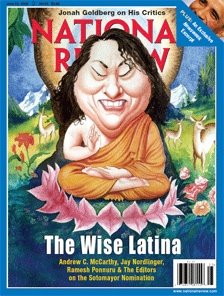
This cover to the right is the current issue of the magazine, on stands now. As you can see, it depicts Supreme Court nominee Sonia Sotomayor as the Buddha. Despite the fact that Sotomayor is Catholic and a Latina woman. While the historical Buddha, Siddhārtha Gautama, was Hindu (before the whole Bodhi tree thing), and an Asian man.
The caption, “The Wise Latina,” frankly offers no real f*cking explanation for the image. I suppose it’s because the Buddha was wise, although you could just as easily have depicted Sotomayor as King Solomon if you’re looking for a legendary figure of wisdom; maybe it’s because to the raving radical Right, Buddha is seen as a proto-hippie and probably a pansy too, while King Solomon, that guy threatened to cut babies in half — not very pro-life, but not “empathetic” either. Badass!
But seriously: If they wanted a figure of wisdom and empathy, why not caricature Sotomayor as someone who’s of the right gender and a coreligionist, at least: Mother Teresa? That would have preserved the necessary level of corrosive offensiveness, right? Too close to home?
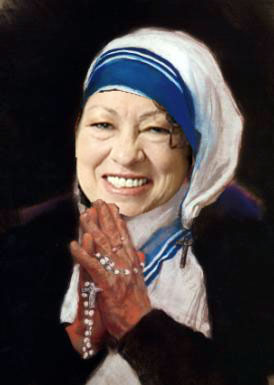
Whatever. As it is, the cover is just stupid and meaningless, as well as offensive — to women, to Latinas, to Buddhists of all backgrounds (note: The National Review guys are of the same ilk that went ballistic when Rolling Stone depicted Kanye as Jesus)…
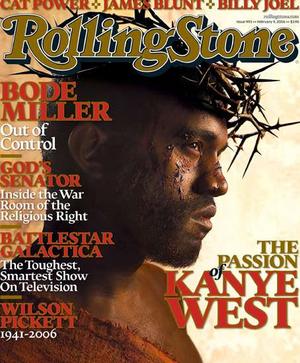
…and yes, to Asians. But it bears mentioning that it registers as EPIC FAIL even in the offending Asians category.
Because, unlike their “Manchurian Candidates” cover, where at least they picked the correct racist stereotypes to parade, the “Wise Latina” cover puts the hideously slanted eyes and bucked teeth of East Asian yellowface stereotype onto an image inspired by a Northern Indian man of Brahmin descent.
In fact…. you can see the original image of Siddhārtha Gautama Buddha that the artist used as a reference (it’s actually quite a popular icon). Notice any differences?

As usual, National Review has been quick with a completely absurd and totally disingenuous retort to the appalled reactions they’ve been getting from, you know, everyone. From editor-in-chief Rich Lowry:
I take it the theory is that we don’t think Latinas can be wise so we had to make her look somewhat Asian. Or something like that. What these people don’t understand is the entire concept of caricature (or of a joke). Caricature always involves exaggerating someone’s distinctive features, which is all that our artist Roman Genn did with Sotomayor. Oh, well. Keep it humorless, guys, keep it humorless.
No, Rich, the theory is that you took a Latina woman and turned her into a North Indian man with horribly racist East Asian-stereotypical features because you guys are clueless morons. And actually, that’s kind of funny, in that Lowry and the National Review don’t quite get that the joke, ultimately, is on them.
NEW! Kate M. pointed out an image similar to the one of Sotomayor as the “wise Latina.” This one is of Newt Gingrich as a “guru” and ran in the liberal magazine Mother Jones:
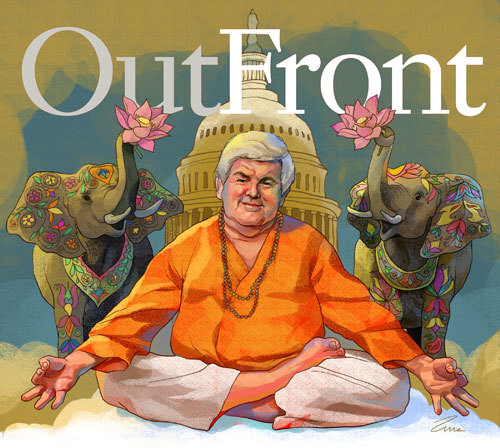
Is this more or less offensive than the Sotomayor example cover? The thing that I think distinguishes the two is that Gingrich’s features are not exaggerated into a warped stereotype of Asian features, possible the most offensive element of the Sotomayor caricature.
——————————-
Jeff Yang is the editor-in-chief at Secret Identities: The Asian American Superhero Blog and the Asian Pop columnist for the San Francisco Chronicle. You can follow him on Twitter and friend him on Facebook.
If you would like to write a post for Sociological Images, please see our Guidelines for Guest Bloggers.